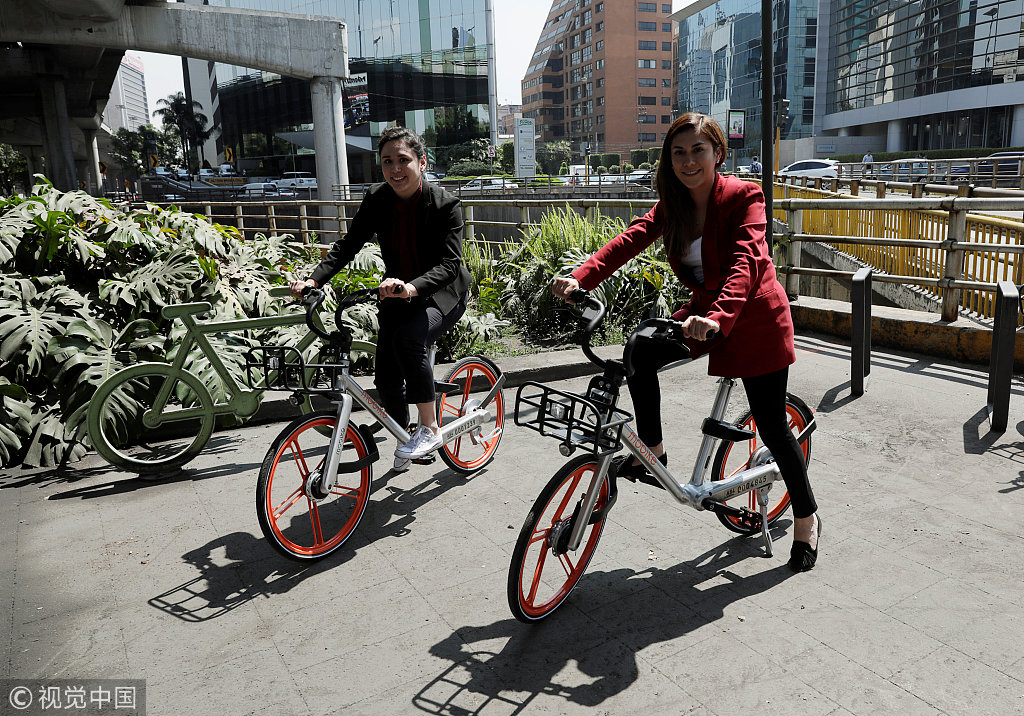59-year-old Polael starts her day at 7am, making auto parts in a workshop in Watertown, Connecticut. It’s hard to believe that 10 years ago, she and her workmates were on the verge of losing this job.

Women ride Mobikes on an avenue after Chinese bike sharing company MOBIKE launched its service in Mexico City, Mexico February 28, 2018. (Photo: VCG)
Global Steering Systems, the US company which Polael works for, was close to being closed down due to a problem in the capital chain. In 2009, Wanxiang America Corporation, the Chicago-based arm of China’s Wanxiang Group Company, took over the business, saving US factories and secured thousands of jobs for American workers.
Decades ago, Wanxiang Group Company was only an agricultural machinery repair factory. It was China’s reform and opening up that allowed the Chinese company to go to the US and pull the company out of trouble.
Go abroad
Wanxiang established in 1969 in Zhejiang city of east China’s Hangzhou province, expanding its auto part manufacturing business to the US in response to the reform and opening-up policy.
In the early years of reform and opening-up, Chinese products were exported via commerce companies, but the latter had only sales departments and lacked marketing departments, resulting in insufficient understanding of products and a waste of money and time, said Ni Pin, president of Wanxiang America Corporation.
Ni said the then president of Wanxiang told them to work hard to become capable of making products of the same quality as their US counterparts.
Now, Wanxiang America owns 21 factories in the United States. It has become the largest China-invested company in the middle and west of the states with its business covering various spots of auto manufacturing. It is estimated that one out of every two cars manufactured in the US is supported by Wanxiang auto parts.
Ni said Wanxiang has saved many US companies on the verge of bankruptcy, learnt advanced technologies and built a good reputation in the country.
Reform and opening up has triggered the sense of competition among Chinese enterprises and enhanced their adaptation to globalization.
Make US companies change
Global Steering Systems found itself back on track after receiving help from Wanxiang. Since then, the company has built factories in Mexico, Poland and China, said the CEO of Global Steering Systems.
Now enterprises in 25 US states are Wanxiang-invested or acquired, with a total local staff of 9,000 people. To show gratitude to the Chinese company, the state of Illinois named August 12, 2002, “Wanxiang Day”.
Wanxiang is just one of the many Chinese companies going abroad following the tide of reform and opening up.
According to the report, the cumulative value of US foreign direct investment (FDI) in China reached $256 billion between 1990 and 2017, while the cumulative Chinese FDI in the US totaled $140 billion in the same period.
According to industry insiders, besides creating job vacancies for local people, Chinese companies such as automaker BYD have invested in relatively poor areas in the US to help more people get employed.
In the past, the Chinese companies hoped to learn about technologies and increase sales through their acquisitions, but now they pay more attention to the brands and opening more sales channels in a bid to expand their overseas market.
Ni thinks reform and opening up has not only propelled Chinese manufacturing to upgrade, but also made US manufacturers develop from just offering services to focusing on their own strengths.
From one-way to two-way investment
In 2013, Global Steering Systems opened a plant in Changshu in east China’s Jiangsu province. The supply and development head of the company said recruiting Chinese engineers highlighted the company’s advantages because they know China well.
Lu Weiding, chairman of Wanxiang, said the company has gradually transferred its role from an investor to a magnet of investment that attracts foreign equities and distributes the work.
At the beginning of the reform and opening up, China played the role of recipient of US investment. However, as the reform deepened and the opening up broadened, the China-US investment has become two-way.
In 2016, Chinese enterprises invested $46 billion directly in the US, a record high; and the US companies’ annual investment in China has stayed at $13 billion per year.
“In the current world, countries need each other,” said an economy official in Watertown, who has learnt from the acquisition of Global Steering Systems that the US should abandon the idea that it “can do everything independently”.


